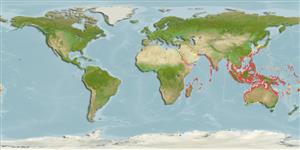Common names from other countries
Environment: milieu / climate zone / depth range / distribution range
Ecologia
; intervalo de profundidade 0 - 30 m (Ref. 348), usually 0 - 25 m (Ref. 75831). Tropical
Indo-Pacific: from East Africa, to Melanesia; north to Japan and south to Queensland and Western Australia.
Length at first maturity / Tamanho / Peso / Idade
Maturity: Lm ? range ? - ? cm Max length : 14.0 cm SHL macho/indeterminado; (Ref. 348); common length : 9.5 cm SHL macho/indeterminado; (Ref. 348)
Occasionally used for food by coastal populations, this species is nowadays mainly collected for its beautiful shell (Ref. 348). Found in intertidal areas on rocks (Ref. 75831).
Life cycle and mating behavior
Maturidade | Reprodução | Desova | Ovos | Fecundidade | Larvas
Members of the class Bivalvia are mostly gonochoric, some are protandric hermaphrodites. Life cycle: Embryos develop into free-swimming trocophore larvae, succeeded by the bivalve veliger, resembling a miniature clam.
Poutiers, J.M. 1998. (Ref. 348)
Status na Lista Vermelha da IUCN (Ref. 130435)
Status no CITES (Ref. 108899)
Not Evaluated
Not Evaluated
Perigo para os humanos
Harmless
Uso pelos humanos
| FishSource |
Ferramentas
Mais informação
Idade/TamanhoCrescimentoComprimento-pesoComprimento-comprimentoMorfologiaLarvasAbundância
Fontes da internet
Estimates based on models
Preferred temperature
(Ref.
115969): 24.4 - 29.1, mean 28 (based on 1424 cells).
Vulnerabilidade
Low vulnerability (10 of 100).
Categoria de preço
Unknown.
